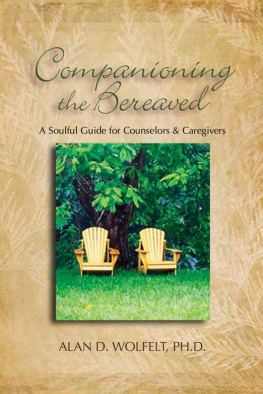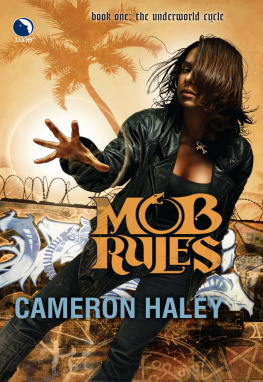
First published 2002 by the Baywood Publishing Company, Inc.
Published 2018 by Routledge
2 Park Square, Milton Park, Abingdon, Oxon OX14 4RN
52 Vanderbilt Avenue, New York, NY 10017
Routledge is an imprint of the Taylor & Francis Group, an informa business
Copyright 2002 Taylor & Francis
All rights reserved. No part of this book may be reprinted or reproduced or utilised in any form or by any electronic, mechanical, or other means, now known or hereafter invented, including photocopying and recording, or in any information storage or retrieval system, without permission in writing from the publishers.
Notice:
Product or corporate names may be trademarks or registered trademarks, and are used only for identification and explanation without intent to infringe.
ISBN 13: 978-0-89503-256-0 (pbk)
ISBN 13: 978-0-415-78594-5 (hbk)
T his is dedicated to Ms. Norma Wylie, MSN, Professor Emerita of Southern Illinois University School of Medicine and author of Sharing the Final Journey. She has been my mentor and friend in matters of loss adjustment. In both academic and counseling communities, she has gone out ahead, scouted scary places, returned and shown others a safe way through. By discourse and by example, she has taught that the best way to face grief is with all your heart, mind, and soul. And a touch of humor doesnt hurt.
Also, in matters of loving, grieving, healing, and laughing, i.e., lifethis is dedicated to my parents: the late Ann Katherine Moon Haley, who always knew to make love your aim; and my dad, Foster A. Haley, still proving to my brother Paul and me how even middle-aged men thrive on a fathers love.
G racias a Diosthanks be to God.
Several others get a big thank you, as well. For their reviews and recommendations, my sincere appreciation goes to: my long time hospice buddy Carolyn Loshuertos; the Friday Breakfast boys... Bob Loshuertos, Jim Norris, and Frank Broyles (all clergy, of different stripes); Richard Moore, the English professor I asked to look over my shoulder; Houston Hodges, author, pastor, and chronic encourager; my lovely wife Adrianne, master of detail and constant support; and Sheryl Fullerton, editorial advisor adding professionalism with grace. Also, thanks to friend and author Alan Briskin, who, having never seen this guide, helped steward it to success.
H as your pen ever hovered above a blank page while you puzzled about what to say to someone who has experi\xADenced the death of a loved one? Have you felt that this time the sympathy card alone would not be enough? If so, would you like some help putting your own words to paper?
Whether the recipient is family or friend, parishioner or patient, client or customer, the following suggestions can help when that empty page stares back at you. With this guide, you will leam how to draw on your own knowledge and experience to create highly personalized messages. You will find unique ways to extend reassurance into the swirling vortex of loss and adjustment. You will not only get the letter written, you will enrich it with personal meaning and restorative power.
You may even help heal yourself.
I n addition to the natural circle of friends and family, there are numerous capacities in which professionals, lay people and volunteers may find themselves in need of this assistance. Here are just a few:
Hospices, for ...
All members of the care team, clinical and otherwise
Patients friends and families
Volunteer training
Community education
Funeral homes, for ...
Visitation guests
Funeral service guests
Staff members
Bereavement support groups, for ...
Group members
Visitors
Public education
Clergy of all faiths, for ...
Direct personal and professional use
Lay care-giving training
Seminaries and colleges
Judicatory/denominational offices
Psychological, psychiatric and counseling professionals, for...
Direct personal and professional use
Workshops and seminars
Supplemental resource material for clients/patients
Extended care and nursing home facilities, for ...
Residents friends and families
Clinical staff members
Adjunct staff members
Hospitals, for ...
Clinical staff members
Chaplains
Social workers
Gift shops
And a wide range of specialties like nurse oncology associations, veterans groups, life insurance agents, plus greeting card stores, florists, and more.
Nearly all of the above groups have national, state and/or local organizations that may want to make this resource known to their members.
This list is hardly exhaustive. In the end, who wont find themselves befriending someone surviving great loss? If that act of friendship takes the form of a written message, the following considerations may serve you now.
F irst, relax. Your high school English teacher isnt lurking over your shoulder here, pen poised to strike with the red ink. Second, dont concern yourself with the length of the message. A twenty-page epistle would be overwhelming, of course, but for the usual intent of sympathy and condolence, you will do best to focus on matters that truly stir you to comment. Then say no moredont artificially stretch it out.
Simple openings are fine. A letter of condolence can begin by plainly acknowledging that you have learned the news and by expressing your feelings. For example:
Dear Pamela,
Only yesterday I heard that your mother died of a stroke late last month. I had not known she was ill, and I am saddened to leant of her death.
Also, you may wish to portray your circumstances or activities when the news arrived. For instance:
I had put the children to bed, and settled into my evening reading when your brother William called.
The simplicity of these passages convey more significance than you might think because it begins a healing process.
Heres how: Death frequently evokes a sense of disorientation. By briefly describing how you learned of the death and what you were doing at the time, you help the bereaved person perceive this event as meaningful in other peoples lives as well, thus making it more real. When we do this, we validate one anothers experience, somewhat like when we exchange details of what we were doing when a tragic public event occurred.
Such descriptions of tangible circumstances help anchor the eerie feelings of great loss into concrete details of time, place and activity. Do you remember the saying, Joy shared is multiplied; pain shared is divided? When you validate and participate in loss, you begin to lessen its impact on the survivor.
O nce you begin the letter, you may wish to mention one or more favorite memories of the deceased. If the memories are meaningful to you, they are capable of enlarging the recipients awareness of the impact their loved one had on you (and others) during life. Thoughtful reminiscences help paint the mural of scenes from that life and, by implication, convey deeper appreciation for the survivors grief. Indeed, in this way we frequently learn stories about our loved ones that were unknown while they were alive!
In recalling tales of days past, be honest while being kind. Do not exaggerate feelings of loss or sadness beyond what you genuinely feel. A brief, sincere note comforts better than an artificially extended letter.
Next page














